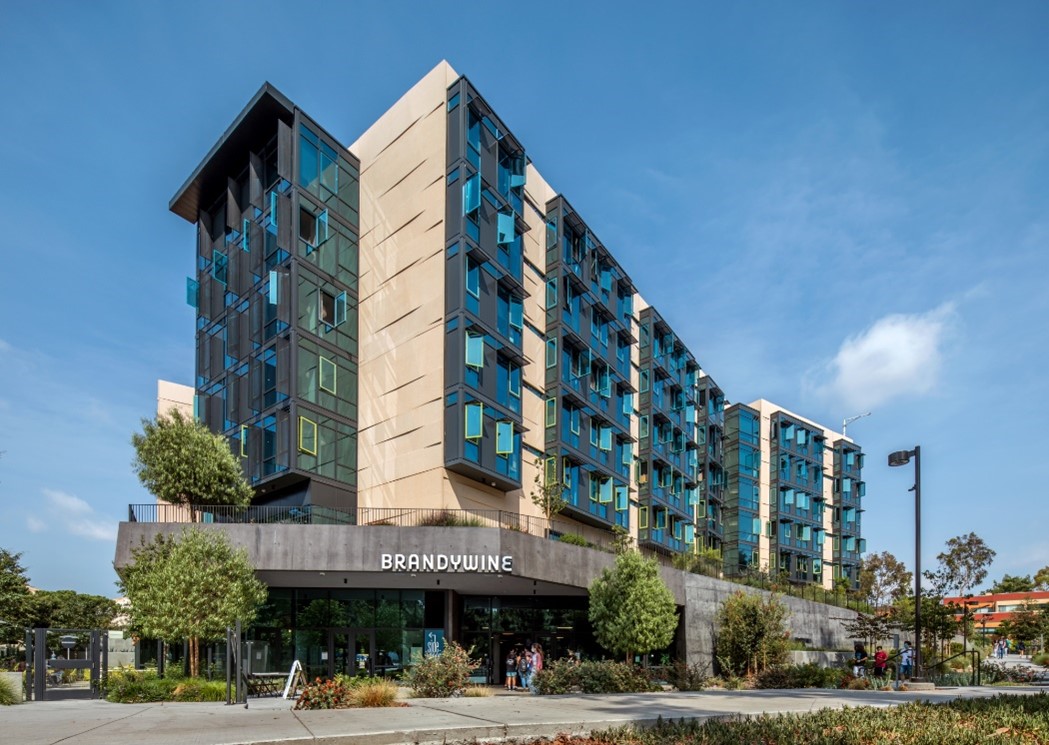Solarban® R67 Solexia® Glass Maximizes Daylight for a Southern California Higher Education Mixed Use Facility

 Photography by Tom Kessler
Photography by Tom Kessler
PITTSBURGH, PA May 17, 2022 — Striking the ideal balance between maximized daylighting and controlled heat gain, Mithun architects selected Solarban® R67 (formerly Solarban® 67) Solexia® glass by Vitro Architectural Glass (formerly PPG Glass) for the LEED® Platinum-certified Middle Earth Expansion for the University of California, Irvine’s (UCI) living-learning community.
The new 6-story, 215,000 sq. ft., mixed-use facility promotes a “see and be seen” vibe with 30% of its façade clad with glass. Enhancing the transparency, operable windows deliver natural ventilation to 80% of the spaces in the building.
“We worked with our mechanical engineer to find the right product that allowed a balance of light transmittance with the appropriate solar heat gain coefficient,” relates Bill LaPatra, AIA, LEED AP, Partner, Mithun, Seattle.
Solarban® R67 Solexia® glass emerged as the best option. Engineered with a proprietary double-silver, magnetron-sputtered vacuum deposition (MSVD) coating, Solarban® R67 glass accurately transmits and reflects the tone and brightness of ambient light and color while delivering excellent solar control. Combined in a one-inch insulating glass unit with Solexia® glass, it provides a solar heat gain coefficient (SHGC) of 0.25 and a visible light transmittance of 47%.
Daylight penetrates beyond the student housing suites deep into adjacent learning and amenity spaces including the skylit 900-seat dining center, student gathering spaces, resource center, multipurpose classrooms and administrative areas. The site also features landscape and plazas for outdoor gathering.
The high-performance glazing, combined with south- and west-facing exterior sunshades and carefully placed operable windows for effective cross ventilation, combine to passively cool the facility. The design is also unique in that it features two to three operable windows in every bedroom suite.
“We performed a post occupancy process to help evaluate the effectiveness of the glass,” reports LaPatra. “Essentially, we asked the staff and students about how the spaces are performing with thermal comfort. We have had great reports on success.”
Mithun carefully selected the frames for the operable windows to reflect the hues of local meadows and sky. “This accent color represents ‘meadow to sky’ colors—a theme that runs through many aspects of the project,” he adds. “We worked very hard at composing beautiful facades with passive design functionality while providing views and vistas for the residents.”
The facility also incorporates a 50 kW roof-mounted, grid-connected photovoltaic system, a stormwater design with two cascading bio-filtration terraced zones and green roofs on all lower levels to reinforce the meadow concept and reduce the heat-island effect. The towers were designed to help UCI achieve its goal of carbon neutrality by 2025.
For more information about Solarban® R67 and Solexia® glasses and the rest of Vitro Glass’s full line of architectural glasses, visit www.vitroglazings.com or call 1-855-VTRO-GLS (887-6457).
About Vitro Architectural Glass
Vitro Architectural Glass, part of Vitro, S.A.B. de C.V. (BMV: VITROA), is the largest glass producer in the Western Hemisphere, manufacturing a range of industry-leading, energy-efficient, high-performance products such as Solarban®, Sungate® and Starphire Ultra-Clear® glasses. Committed to continually raising the industry standard for sustainability, Vitro was the first U.S. glass manufacturer to have its entire collection of architectural glass products earn Cradle to Cradle Certified® status and the first North American manufacturer to publish third-party verified Environmental Product Declarations (EPDs) for flat glass and processed glass products. Additionally, as of April 2024, all Vitro architectural glass products meet the Top 20% Low Embodied Carbon (LEC) material Global Warming Potential (GWP) threshold the U.S. General Services Administration (GSA) established pursuant to the Inflation Reduction Act of 2022 and related guidance from the U.S. Environmental Protection Agency. Vitro operates seven glass production facilities across North America, four residential glass fabrication plants in Canada and one of the world’s largest glass research and development facilities in Pittsburgh, Pennsylvania. For more information, please visit VitroGlazings.com.

Media Contact:
Robert J. Struble
Vitro Architectural Glass
412-820-8138
rstruble@vitro.com
www.vitroglazings.com
